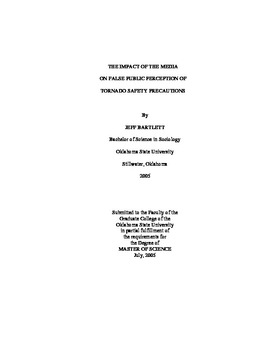| dc.contributor.advisor | Webb, Gary | |
| dc.contributor.author | Bartlett, Jeff N. | |
| dc.date.accessioned | 2014-04-15T22:24:13Z | |
| dc.date.available | 2014-04-15T22:24:13Z | |
| dc.date.issued | 2005-07-01 | |
| dc.identifier.uri | https://hdl.handle.net/11244/9475 | |
| dc.description.abstract | This study reports the findings of college students who completed questionnaires to gauge their perceptions of tornado preparedness and the impact of a video clip showing the wrong safety precautions being successfully employed. The primary source of data for this research comes in the form of survey data which has been collected from several classes of varying levels attended by students of a major university in Tornado Alley during the 2004-2005 academic year. This survey data was coded and statistical methods were performed to search for any statistical significance that may show a connection between certain independent variables when compared to a couple of dependent variables. Cross-Tabulations are performed in an attempt to discover the relationship between the independent and dependent variables. When the data are compared between the independent variables age, sex, college of enrollment, source of information, and self-reported level of preparedness knowledge, and the dependent variables of home safety and highway safety, the resulting information provides the researcher with data that could reflect certain trends of susceptibility. These data suggest that the media does in fact play a role in altering the public perceptions of tornado safety myths. The totals and the cross-tabulations demonstrate that there is in fact a link between the media and false public perception of the Kansas Turnpike Video (KTV) as a source for tornado preparedness. The media does play a significant role in the perceptions and opinions of the public. The Kansas Turnpike Video and similar media do alter the perceptions of the public in terms of tornado safety precautions. This and other videos do confuse people on what to do in a similar situation. This video helps to alter the secondary subculture to disseminate misinformation and allows the primary disaster subculture to be wrong in its approach to the problem. Lack of action by the media helps to continue the persistence of this misconception. | |
| dc.format | application/pdf | |
| dc.language | en_US | |
| dc.publisher | Oklahoma State University | |
| dc.rights | Copyright is held by the author who has granted the Oklahoma State University Library the non-exclusive right to share this material in its institutional repository. Contact Digital Library Services at lib-dls@okstate.edu or 405-744-9161 for the permission policy on the use, reproduction or distribution of this material. | |
| dc.title | Impact of the Media on False Public Perception of Tornado Safety Precautions | |
| dc.type | text | |
| dc.contributor.committeeMember | Caniglia, Beth Schaefer | |
| dc.contributor.committeeMember | Thrasher, Ronald R. | |
| osu.filename | Bartlett_okstate_0664M_1493.pdf | |
| osu.college | Arts and Sciences | |
| osu.accesstype | Open Access | |
| dc.description.department | Department of Sociology | |
| dc.type.genre | Thesis | |
| dc.subject.keywords | public perception | |
| dc.subject.keywords | social construction | |
| dc.subject.keywords | tornado safety myth | |
